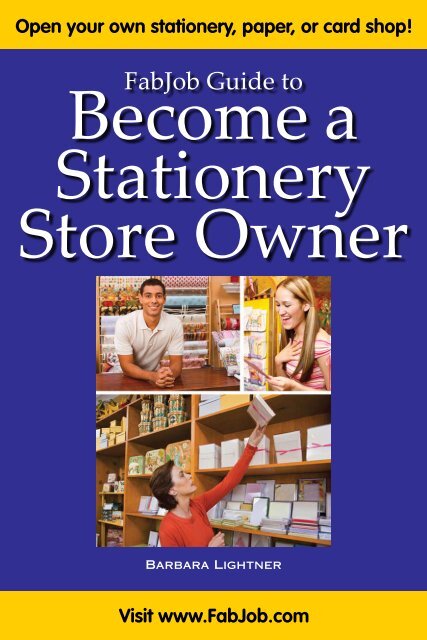Become a Stationery Store Owner - Fabjob.com
Become a Stationery Store Owner - Fabjob.com
Become a Stationery Store Owner - Fabjob.com
Create successful ePaper yourself
Turn your PDF publications into a flip-book with our unique Google optimized e-Paper software.
Open your own stationery, paper, or card shop!<br />
FabJob Guide to<br />
<strong>Be<strong>com</strong>e</strong> a<br />
<strong>Stationery</strong><br />
<strong>Store</strong> <strong>Owner</strong><br />
Barbara Lightner<br />
Visit www.FabJob.<strong>com</strong>
FabJob Guide to <strong>Be<strong>com</strong>e</strong> a <strong>Stationery</strong> <strong>Store</strong> <strong>Owner</strong><br />
Contents<br />
About the Author ..........................................................................................9<br />
1. Introduction ..........................................................................................10<br />
1.1 The <strong>Stationery</strong> Industry ...............................................................11<br />
1.2 Owning a <strong>Stationery</strong> <strong>Store</strong> ..........................................................12<br />
1.2.1 Products ...............................................................................12<br />
1.2.2 Services .................................................................................15<br />
1.3 Benefits of Being a <strong>Stationery</strong> <strong>Store</strong> <strong>Owner</strong> ..............................15<br />
1.4 Inside This Guide .........................................................................17<br />
2. Getting Ready .......................................................................................18<br />
2.1 Skills and Knowledge You Will Need .......................................18<br />
2.1.1 Product Knowledge ...........................................................18<br />
2.1.2 Business Skills .....................................................................21<br />
2.1.3 Interpersonal Skills .............................................................23<br />
2.2 Learning by Doing .......................................................................25<br />
2.2.1 Work in a <strong>Stationery</strong> <strong>Store</strong> .................................................25<br />
2.2.2 Get Volunteer Experience ..................................................26<br />
2.3 Be Your Own “Mystery Shopper” .............................................27<br />
2.4 Learn From Other Business <strong>Owner</strong>s..........................................31<br />
2.4.1 Talk to <strong>Stationery</strong> <strong>Store</strong> <strong>Owner</strong>s .......................................31<br />
2.4.2 Join an Association .............................................................33<br />
2.5 Educational Programs .................................................................35<br />
2.5.1 Business Courses ................................................................35<br />
2.5.2 Paper, Design, and Printing Courses ...............................36<br />
Copyright © 2009 FabJob Inc. • www.fabjob.<strong>com</strong> • 4
FabJob Guide to <strong>Be<strong>com</strong>e</strong> a <strong>Stationery</strong> <strong>Store</strong> <strong>Owner</strong><br />
2.6 Resources for Self-Study ..............................................................37<br />
2.6.1 <strong>Stationery</strong> <strong>Store</strong>s .................................................................38<br />
2.6.2 Websites ...............................................................................39<br />
2.6.3 Magazines and Newsletters ..............................................40<br />
2.6.4 Books ....................................................................................41<br />
2.6.5 Trade Shows ........................................................................43<br />
3. Starting Your <strong>Stationery</strong> <strong>Store</strong> ..........................................................45<br />
3.1 Choosing Your Niche ...................................................................47<br />
3.1.1 Products ...............................................................................48<br />
3.1.2 Services .................................................................................56<br />
3.2 Options for Starting a <strong>Stationery</strong> <strong>Store</strong> .....................................58<br />
3.2.1 Buying an Established <strong>Store</strong>..............................................58<br />
3.2.2 Franchising ..........................................................................65<br />
3.2.3 Opening a New <strong>Stationery</strong> <strong>Store</strong> ......................................70<br />
3.3 Choosing a <strong>Store</strong> Name ...............................................................70<br />
3.4 Your Business Plan .......................................................................72<br />
3.4.1 What to Include in a Business Plan ..................................73<br />
3.4.2 Start-Up Financial Planning ..............................................79<br />
3.4.3 A Sample Business Plan .....................................................88<br />
3.4.4 Business Plan Resources ..................................................104<br />
3.5 Start-Up Financing .....................................................................104<br />
3.5.1 Getting Prepared ...............................................................105<br />
3.5.2 Equity vs. Debt Financing ...............................................107<br />
3.5.3 Borrowing Money .............................................................108<br />
3.5.4 Finding Investors ..............................................................110<br />
3.5.5 Government Programs ....................................................113<br />
Copyright © 2009 FabJob Inc. • www.fabjob.<strong>com</strong> • 5
FabJob Guide to <strong>Be<strong>com</strong>e</strong> a <strong>Stationery</strong> <strong>Store</strong> <strong>Owner</strong><br />
3.6 Legal Matters ...............................................................................114<br />
3.6.1 Your Business Legal Structure ........................................114<br />
3.6.2 Business Licenses ..............................................................120<br />
3.6.3 Taxes ...................................................................................121<br />
3.6.4 Insurance ............................................................................124<br />
4. Setting up Your Retail <strong>Store</strong> ............................................................127<br />
4.1 Finding a Location ......................................................................127<br />
4.1.1 Possible Locations .............................................................127<br />
4.1.2 Points to Consider ............................................................130<br />
4.1.3 Signing Your Lease ...........................................................136<br />
4.2 <strong>Store</strong> Design ................................................................................145<br />
4.2.1 Outside the <strong>Store</strong> ..............................................................145<br />
4.2.2 Inside the <strong>Store</strong>..................................................................148<br />
4.2.3 <strong>Store</strong> Security ....................................................................152<br />
4.3 Displaying Merchandise ...........................................................153<br />
4.3.1 Maximizing Sales ..............................................................154<br />
4.3.2 Creating Window Displays .............................................155<br />
4.4 Retail Equipment and Supplies ................................................158<br />
4.4.1 Items You’ll Need .............................................................158<br />
4.4.2 Suppliers ............................................................................161<br />
4.5 Obtaining Your Inventory .........................................................163<br />
4.5.1 Manufacturers ...................................................................165<br />
4.5.2 Wholesalers .......................................................................166<br />
4.5.3 Prices and Terms ...............................................................167<br />
4.5.4 Consignment .....................................................................168<br />
Copyright © 2009 FabJob Inc. • www.fabjob.<strong>com</strong> • 6
FabJob Guide to <strong>Be<strong>com</strong>e</strong> a <strong>Stationery</strong> <strong>Store</strong> <strong>Owner</strong><br />
5. Running Your Business ....................................................................171<br />
5.1 <strong>Store</strong> Operations .........................................................................171<br />
5.1.1 Developing a Procedures Manual ..................................171<br />
5.1.2 Areas of Operations Checklists ......................................173<br />
5.2 Inventory Management .............................................................175<br />
5.2.1 Inventory Software and POS Systems ...........................175<br />
5.2.2 Inventory Tags and Labels ..............................................177<br />
5.3 Pricing Merchandise ..................................................................178<br />
5.3.1 Guidelines ..........................................................................178<br />
5.3.2 Retail Pricing Formulas ...................................................180<br />
5.3.3 Profit Margin vs. Percentage Markup............................181<br />
5.3.4 Standard Markups ............................................................183<br />
5.4 Getting Paid .................................................................................184<br />
5.4.1 Accepting Debit Cards .....................................................185<br />
5.4.2 Accepting Credit Cards ...................................................185<br />
5.4.3 Accepting Payment Online .............................................186<br />
5.4.4 Accepting Checks .............................................................186<br />
5.5 Financial Management ..............................................................187<br />
5.5.1 Bookkeeping ......................................................................187<br />
5.5.2 Financial Statements and Reports ..................................189<br />
5.5.3 Building Wealth ................................................................198<br />
5.6 Employees ...................................................................................201<br />
5.6.1 When to Hire Help ...........................................................201<br />
5.6.2 Recruiting Staff .................................................................203<br />
5.6.3 The Hiring Process ...........................................................206<br />
5.6.4 New Employees ................................................................209<br />
5.6.5 Developing an Employee Handbook .............................213<br />
Copyright © 2009 FabJob Inc. • www.fabjob.<strong>com</strong> • 7
FabJob Guide to <strong>Be<strong>com</strong>e</strong> a <strong>Stationery</strong> <strong>Store</strong> <strong>Owner</strong><br />
6. Getting and Keeping Customers ....................................................215<br />
6.1 Marketing Your Business ..........................................................215<br />
6.1.1 Advertising ........................................................................216<br />
6.1.2 Free Publicity .....................................................................220<br />
6.1.3 Your Website ......................................................................222<br />
6.1.4 Networking and Referrals ...............................................226<br />
6.1.5 Special Events ....................................................................228<br />
6.1.6 Other Marketing Ideas .....................................................230<br />
6.2 Customer Service ........................................................................231<br />
6.2.1 Greeting Customers .........................................................231<br />
6.2.2 Making the Sale .................................................................233<br />
6.2.3 Return/Exchange Policy ...................................................235<br />
6.2.4 Getting Repeat Business ..................................................237<br />
6.3 Conclusion ...................................................................................241<br />
Copyright © 2009 FabJob Inc. • www.fabjob.<strong>com</strong> • 8
FabJob Guide to <strong>Be<strong>com</strong>e</strong> a <strong>Stationery</strong> <strong>Store</strong> <strong>Owner</strong><br />
1. Introduction<br />
Congratulations on taking the first step towards starting up your own<br />
stationery store, a step into the fast-paced, ever-changing, exciting<br />
world of stationery and related products. You’re about to spend your<br />
days surrounded by beautiful paper, specialty products, creative accessories,<br />
and the people who seek them out.<br />
Most people who are interested in the idea of owning a stationery store<br />
have certain things in <strong>com</strong>mon, so we think we might already know a<br />
little bit about you. Do you love finding a handwritten note in the mail?<br />
Do you stock up on greeting cards and note cards to send for special<br />
occasions and sometimes for no reason at all? Do decorative journals<br />
put you in the mood to write?<br />
Copyright © 2009 FabJob Inc. • www.fabjob.<strong>com</strong> • 10
FabJob Guide to <strong>Be<strong>com</strong>e</strong> a <strong>Stationery</strong> <strong>Store</strong> <strong>Owner</strong><br />
Do you find it hard to resist the pull of a stationery store? Do you just<br />
“have” to go in to check out the displays whenever you pass a stationery<br />
store? If your preference is printed to-do lists and memo pads over<br />
blank paper, if you believe a decorative storage box is so much nicer<br />
than using an old shoe box, then you already know the special place<br />
stationery products hold for many people.<br />
Chances are you’ve spent a bit of time shopping in stationery stores<br />
and you might possibly have worked in one or two. While it can be fun<br />
and rewarding to work in someone else’s shop, nothing quite <strong>com</strong>pares<br />
to the satisfaction of running your own business.<br />
This chapter lays the foundation for the rest of the guide. It identifies<br />
some of the growth trends in the stationery industry and explains the<br />
difference between office supplies stores and stationery stores. It also<br />
covers the benefits of this exciting career choice and outlines the steps<br />
needed to get started.<br />
1.1 The <strong>Stationery</strong> Industry<br />
As you start out in your new business, have confidence that you will<br />
be part of a highly select and ever-growing market. According to the<br />
most recent figures available from the U.S. Bureau of the Census, office<br />
supplies and stationery stores were a $24 billion industry in the United<br />
States in 2007, with stationery stores making up around $8 million of<br />
the overall industry.<br />
The office supplies and stationery store industry en<strong>com</strong>passes a variety<br />
of products sold at stores from the small independent stationery<br />
store to the large office supply superstore chains like Staples, Office<br />
Depot, and OfficeMax. Items sold in these stores include office supplies,<br />
such as office products, forms, furniture, and equipment; school<br />
supplies; writing supplies; stationery; greeting cards; gifts; and home<br />
decor items. For decades, independent stationery stores sold merchandise<br />
from all of these categories. With the rise of the superstore chains<br />
in the 1980s and 1990s, many stationery stores stopped carrying products<br />
in many of these categories and started carrying more stationery<br />
products, greeting cards, gifs and novelties, and related items, such as<br />
picture frames.<br />
Copyright © 2009 FabJob Inc. • www.fabjob.<strong>com</strong> • 11
FabJob Guide to <strong>Be<strong>com</strong>e</strong> a <strong>Stationery</strong> <strong>Store</strong> <strong>Owner</strong><br />
Since stationery stores sell a variety of products not classified as office<br />
supplies and stationery, the actual sales of stationery stores are much<br />
higher than those reported by the U.S. Bureau of the Census. In addition<br />
to the office supplies and stationery industry segment, stationery<br />
stores sell items from a variety of industries. Most notable among<br />
these are greeting cards, party supplies, and gifts. The market research<br />
firm Unity Marketing, Inc. reports that sales of stationery products that<br />
cross all industries were $37.4 billion in the United States in 2007. Based<br />
on the total sales of products sold in stationery stores, the per capita<br />
spending in stationery stores equaled nearly $123.<br />
Unity Marketing also reports on trends in the stationery market. Consumers<br />
are showing a growing preference for smaller, specialty, and/or<br />
independent stationery retailers as opposed to large national retailers.<br />
Despite overall declines in retail spending, certain stationery products<br />
showed modest gains in sales. The most dramatic growth was sales of<br />
luxury, specialty, and custom-printed products, such as custom-printed<br />
stationery. Whereas sales declined for items such as party goods, gift<br />
wrap, and specialty writing instruments, these categories are expected<br />
to regain their popularity once economic conditions improve.<br />
According to Unity Marketing, based on consumer shopping behavior,<br />
the best marketing opportunities in the stationery field will be for<br />
stores selling specialty and luxury items. More and more consumers<br />
are turning away from mass merchants and to independent stationery<br />
stores for their stationery needs, and this trend is expected to continue<br />
in the <strong>com</strong>ing years.<br />
1.2 Owning a <strong>Stationery</strong> <strong>Store</strong><br />
1.2.1 Products<br />
Holding a venerable place in the retail industry for decades, stationery<br />
stores experienced many challenges that threatened their existence and<br />
ways of doing business in the 1980s and 1990s. Chief among these was<br />
the advent of the <strong>com</strong>puter and the way it changed business practices<br />
and <strong>com</strong>panies’ reliance on office products and stationery stores to supply<br />
all of their business <strong>com</strong>munication, forms, and paper needs. Next<br />
was the emergence of the superstore and its growing dominance as a<br />
Copyright © 2009 FabJob Inc. • www.fabjob.<strong>com</strong> • 12
FabJob Guide to <strong>Be<strong>com</strong>e</strong> a <strong>Stationery</strong> <strong>Store</strong> <strong>Owner</strong><br />
one-stop source for products formerly purchased primarily at smaller<br />
office supplies and stationery stores.<br />
In order to survive and prosper, stationery stores had to reinvent themselves—and<br />
they did. Today, many stationery stores no longer sell office<br />
supplies and products. They sell a vast array of products, from<br />
novelty pens and fun wall stickers to fine handcrafted papers and luxurious<br />
boxed stationery. The primary products sold in stationery goods<br />
include stationery, invitations, announcements, paper, greeting cards,<br />
party supplies, gift wrap and packaging goods, and gifts.<br />
The heart of many stationery stores today is not to supply local businesses<br />
with all of their office supply needs but to provide both businesses<br />
and individuals with products that allow them to <strong>com</strong>municate<br />
and connect with other people. <strong>Stationery</strong> stores continue to supply<br />
<strong>com</strong>panies with business stationery, business cards, and related supplies,<br />
but there is a far greater focus on individuals—and a far greater<br />
diversity among stationery stores and their targeted markets.<br />
Some stationery stores sell high-end stationery made of the finest materials.<br />
They target the most discerning customers who seek the best<br />
stationery in the world and are willing to pay the high price such stationery<br />
<strong>com</strong>mands. Other stationery stores sell less expensive stationery<br />
and a variety of products that allow for personal expression and <strong>com</strong>munication.<br />
They may carry journals, note cards, and greeting cards as<br />
well as novelties such as word games and decorative photo frames.<br />
Many stationery stores sell items that allow people to celebrate life’s<br />
special moments—from the small moments such as wishing a person a<br />
good day to births, birthdays, weddings, anniversaries, romance, and<br />
graduation. They sell greeting cards, invitations, and announcements.<br />
They may sell party supplies such as tabletop decorations, streamers,<br />
and party favors. Other items frequently sold are gift wrap, ribbons,<br />
toppers (decorative items to “top” off a wrapped gift), and packaging<br />
supplies such as gift bags and boxes.<br />
One of the biggest categories for many independent stationery stores is<br />
wedding items. Wedding items include not only the invitations and announcements,<br />
but many related accessories such as guest books, pens,<br />
wedding albums, photo cards, place cards, picture frames, and framed<br />
seating charts. Because weddings are a momentous occasion, many<br />
Copyright © 2009 FabJob Inc. • www.fabjob.<strong>com</strong> • 13
FabJob Guide to <strong>Be<strong>com</strong>e</strong> a <strong>Stationery</strong> <strong>Store</strong> <strong>Owner</strong><br />
customers seek a number of items that will help them to make the day<br />
special and create memories for years to <strong>com</strong>e.<br />
<strong>Stationery</strong> stores may target a youthful market looking for fun, off-beat,<br />
and funky items or an older market looking for more sophisticated and<br />
fine items. In both cases, customers are seeking items that are different<br />
than what they would find in a mass market store. They want unique<br />
items that allow them to <strong>com</strong>municate and connect with others in an<br />
individual, personalized way. And they want things that are nicer, a bit<br />
more special, than what they would find elsewhere.<br />
Products that allow people to express themselves and <strong>com</strong>municate<br />
quickly and without extensive writing are gaining in popularity. Many<br />
people love to express themselves through personalized written <strong>com</strong>munication<br />
but lack the time and means for lengthy correspondence.<br />
Greeting cards and note cards provide the perfect means for these <strong>com</strong>municators.<br />
Sticky notes also are rapidly gaining popularity among the<br />
time-challenged <strong>com</strong>municators.<br />
Current trends in the stationery industry closely follow those in other<br />
retail segments, such as fashion and gifts. As with the fashion industry,<br />
the most popular colors change with the season. Past seasons have<br />
shown popular colors such as bright pink and orange or chocolate and<br />
light blue. One year bold prints may be in; the next year subtle intricate<br />
designs may be popular.<br />
One trend that has remained constant throughout the past decade has<br />
been nature themes. Consumer interest in the environment is high, and<br />
this interest is reflected in designs and patterns used in stationery products.<br />
In 2008, many stationery items reflected this theme with bird motifs.<br />
In years past, flowers were popular. Similarly, animal and nature<br />
patterns are popular, although the type of patterns varies from year<br />
to year. One year it may be cheetah prints or wood grains. The next it<br />
may be zebra prints. Because consumer interests and preferences can<br />
fluctuate wildly, it is impossible to predict what specific trends will be<br />
popular when you open your store. In order to stay on top of the most<br />
current trends, you will want to closely monitor trends through industry<br />
publications and trade shows (see sections 2.6.3 and 2.6.5).<br />
Copyright © 2009 FabJob Inc. • www.fabjob.<strong>com</strong> • 14
FabJob Guide to <strong>Be<strong>com</strong>e</strong> a <strong>Stationery</strong> <strong>Store</strong> <strong>Owner</strong><br />
1.2.2 Services<br />
At one time, stationery stores were the prime place for business and<br />
personal printing needs. Business printing included custom forms, letterhead<br />
and envelopes, business cards, and other items. Printing for<br />
individuals included holiday cards, invitations, and social stationery.<br />
With the advent of the <strong>com</strong>puter, the need for these types of printing<br />
declined significantly. Yet, as they did with other changes during the<br />
1980s and 1990s, many stationery stores adapted by offering new printing<br />
services.<br />
<strong>Stationery</strong> stores may do in-store printing or send items out to be printed,<br />
depending on the printing technology and store resources. <strong>Store</strong>s<br />
that do a significant amount of printing may invest in the equipment<br />
for doing the majority of their printing in house, whereas stores that do<br />
a limited amount of printing find it more economical to send items to<br />
printers.<br />
Printing services allow customers to personalize stationery, greeting<br />
cards, invitations, announcements, and other items. Inkjet and laser<br />
printing are the most <strong>com</strong>mon forms of printing and are used for stationery,<br />
envelopes, invitations, announcements, nametags, place cards,<br />
certificates, programs, and brochures. Other printing methods are letterpress,<br />
thermography, engraving, and offset.<br />
1.3 Benefits of Being a<br />
<strong>Stationery</strong> <strong>Store</strong> <strong>Owner</strong><br />
Financial Rewards<br />
Owning a stationery store can be a fulfilling and rewarding career. In<br />
addition to the benefits of working for oneself, it offers financial benefits<br />
to owners who work hard and satisfy a market niche. According to<br />
the U.S. Census Bureau, the average annual sales for office supplies and<br />
stationery stores are over $2 million per establishment. Since this figure<br />
includes sales of large superstores, it’s hard to predict how much an<br />
independent stationery store would bring in a year, especially during<br />
its early years. Based on Census reports that about 40% of year-round<br />
shops have annual sales in the $100,000 to $999,999 range, successful<br />
stationery store owners can expect lucrative earnings.<br />
Copyright © 2009 FabJob Inc. • www.fabjob.<strong>com</strong> • 15
FabJob Guide to <strong>Be<strong>com</strong>e</strong> a <strong>Stationery</strong> <strong>Store</strong> <strong>Owner</strong><br />
Providing a Needed Product or Service<br />
Many stationery store owners opened their shop because they saw an<br />
unmet need in their <strong>com</strong>munity and wanted to fill it. Knowing that<br />
they are offering the <strong>com</strong>munity something of value brings them great<br />
pleasure. Terry Clougherty, owner, Carmody & Co., sums this up: ““I<br />
opened my store to provide a great product to the customers in my<br />
<strong>com</strong>munity.” Kristie Lee Wagner, owner, Anjénu, agrees, stating that<br />
what she finds most rewarding is “the customers. When someone<br />
<strong>com</strong>es in and finds ‘the perfect card’ it is enough to make my day. I<br />
know at that moment I did my job well. When customers walk in and<br />
say, ‘This is so cute’ or ‘I love this shop’ it can be so rewarding.”<br />
Building Relationships<br />
Many store owners derive great satisfaction in developing relationships<br />
with customers and employees and seeing the satisfaction of delighted<br />
customers. Cathy Zuniga, owner, Paperie & Co., explains that what she<br />
finds most rewarding is the enjoyment she has in building relationships<br />
with her staff and her customers. She says, “The most rewarding<br />
thing for me owning a store is the personal relationships I have developed<br />
with my customers. Be it a bride that returns time and again,<br />
then be<strong>com</strong>es a mother and returns time and again and then brings<br />
her children in to start them on stationery products, to just a customer<br />
searching for a unique and personal gift. Every customer is special to us<br />
and we try to insure that is felt in our store.”<br />
Sharing a Passion for Paper<br />
Several stationery store owners opened their stores because they had a<br />
passion for paper and stationery products and wanted to share it with<br />
others. Chantal Osborne and Aledia Alonso, stationery designers and<br />
co-owners, Stylish Invitations Designs, describe their reasons for opening<br />
a stationery store as “we love the art of creating, designing new<br />
stationery, the look and feel of paper, and being entrepreneurs.” Cathy<br />
Zuniga, owner, Paperie & Co., describes one of the rewards she reaps<br />
by owning a stationery store: “I love seeing a bride light up and get<br />
excited when she sees her dream <strong>com</strong>e to life.”<br />
Copyright © 2009 FabJob Inc. • www.fabjob.<strong>com</strong> • 16
FabJob Guide to <strong>Be<strong>com</strong>e</strong> a <strong>Stationery</strong> <strong>Store</strong> <strong>Owner</strong><br />
1.4 Inside This Guide<br />
The FabJob Guide to <strong>Be<strong>com</strong>e</strong> a <strong>Stationery</strong> <strong>Store</strong> <strong>Owner</strong> is organized to help<br />
take you step-by-step through the basics you will need to open and operate<br />
your own store. The chapters are organized as follows:<br />
Chapter 2 (“Getting Ready”) explains how to learn the skills you will<br />
need as a stationery store owner. It covers ways of learning from experts<br />
and through observation, <strong>com</strong>munications, research, and handson<br />
activities.<br />
Chapter 3 (“Starting Your <strong>Stationery</strong> <strong>Store</strong>”) will help you decide what<br />
kind of store you should open. This chapter discusses different products<br />
you can sell and will help you decide whether to buy an existing<br />
store, operate a franchise, or open a new store. It also explains what you<br />
need to get started, including your business plan, start-up financing,<br />
store name, and other important matters.<br />
Chapter 4 (“Setting Up Your <strong>Store</strong>”) offers the information you need to<br />
actually set up your store. It gives advice on how to choose a location,<br />
get merchandise to sell, and arrange displays. You will also discover<br />
what equipment and supplies you will need, and how to find suppliers<br />
for obtaining your inventory.<br />
Chapter 5 (“Running Your Business”) takes you into the day-to-day challenge<br />
of running your store once it’s open. It explains how to develop a<br />
procedures manual and an employee handbook, and covers inventory<br />
management, financial management and pricing, marketing your business,<br />
and working with staff and customers.<br />
Chapter 6 (“Getting and Keeping Customers”) tells you ways to build up<br />
your customer base and how to keep your customers happy so they<br />
keep <strong>com</strong>ing back. It describes ways to promote your shop through<br />
advertising, press releases, a website, and other marketing techniques.<br />
It describes quality customer service—and how to ensure you are providing<br />
it so you keep customers <strong>com</strong>ing back.<br />
By following the steps in this guide, you will be well on your way to<br />
living your dream — opening your own successful stationery store.<br />
Copyright © 2009 FabJob Inc. • www.fabjob.<strong>com</strong> • 17








